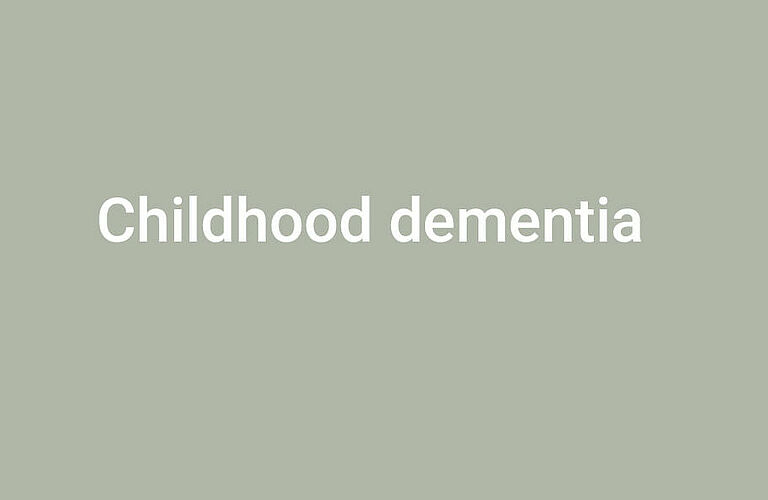Progressive loss of cognitive abilities
Dementia is not just a matter of age. Children and adolescentscan also be affected by progressive neurodegenerative diseases. More than 250 different disorders are now known to affect the cognitive abilities of children. These conditions are referred to as "childhood dementia" and are among the rare diseases: Depending on the form of the disease, childhood neurodegeneration affects between 1 in 2,000 and 1 in 500,000 newborns. Examples include the cerebral form of X-linked adrenoleukodystrophy (X-ALD), metachromatic leukodystrophy (MLD), neuronal ceroid lipofuscinoses (NCL), and Alper's syndrome. Some forms of childhood dementia are so rare that experts have described only a few cases worldwide. An example of an ultra-rare childhood neurodegenerative brain disease is multiple sulfatase deficiency.
In most cases, the affected children and adolescents initially develop without any noticeable problems and have age-appropriate cognitive and motor skills. Depending on the form of the disease, however, they lose these abilities without stopping. There are disruptions or the complete loss of motor and cognitive skills and, in many cases, hearing and visual impairments. Many of the young patients also suffer from seizures. The affected children become increasingly dependent on care and eventually bedridden. In most cases, the diseases lead to death in the first two decades of life. How early symptoms appear and how quickly they worsen depends on the particular form of the disease.
Genetic metabolic disorders
Childhood dementia is caused by hereditary genetic defects that often result in an impaired metabolism in the brain. This can mean that either important building blocks for the structure, maintenance, and function of brain tissue and neurons are missing or toxic metabolites are not properly broken down and are deposited. As a consequence, neurons become damaged and eventually die.
In 2009, the team led by Prof. Dr. Jutta Gärtner, a pediatric neurologist from Göttingen, Germany who also conducts research at the DZNE, discovered and described for the first time a previously unknown form of childhood dementia: cerebral folate deficiency (CFD). The researchers recognized that defective transport systems prevent folate – an essential substance for healthy brain function – from being transported from the blood to the brain. With this knowledge, it was possible to identify the defective transporter at the blood-brain barrier and to develop a therapy. Affected children are administered folate into the blood and directly into the cerebrospinal fluid, which, if treated soon enough, can prevent the onset of neurodegeneration and thus the disease manifestation or, once onset has occurred, the progression of the disease.
Effective treatment approaches also exist for some other of these rare neurodegenerative diseases in children, in which missing substances or enzymes are supplied externally, such as in MLD and a special form of NCL. For some diseases, such as X-ALD, transplantation of blood-forming stem cells (hematopoietic stem cells) or gene therapy may be helpful. However, even though there are already effective therapeutic approaches for a few childhood neurodegenerative diseases, there is no causal therapy that can bring about a complete cure for the majority of these diseases.
Understanding childhood dementia – improving diagnosis and treatment options
Researchers at the DZNE are investigating in detail the genetic background and the biochemical and cellular mechanisms that lead to manifestation and progression of the disease. In doing this, they want to create the basis for new therapeutic approaches for the various diseases. This can be achieved, for example, if it is known which enzyme or which substance is missing in the body of the affected child and the scientists find a way to get it into the brain.
Another important area of research is devoted to the parallels between forms of childhood dementia and adult neurodegenerative diseases. Scientists hope to achieve synergy effects from a better understanding of the similarities and differences between these diseases. Findings from research on dementia in childhood could, for example, help to find better therapeutic approaches for adults with dementia and vice versa.
Finally, researchers are also searching for suitable biomarkers to detect various forms of childhood dementia as early as possible and to make an accurate diagnosis. An early diagnosis is crucial, for example, for those childhood dementias in which it is possible to prevent manifestation or at least to slow or even stop the neurodegenerative course by administering the missing or defective substances. The earlier treatment begins, the less the loss of neurons and thus motor and cognitive abilities. Since lost nerve tissue in children cannot be sufficiently regenerated, early therapy is crucial for their future life.
Example of childhood dementia, which was described almost 200 years ago
It was in 1826 that the Norwegian physician Otto Christian Stengel first described cases of childhood dementia. In the southeastern Norwegian municipality of Røraas, he met a family with four children – two boys and two girls – who all first lost their vision from the age of six and later successively lost their speech and ability to think. The children also suffered from epileptic seizures. All four died early. Stengel's description matches those of the symptoms of the juvenile form of neuronal ceroid lipofuscinosis (CLN3). He published his observation in a Norwegian medical publication, but it did not attract any attention.

